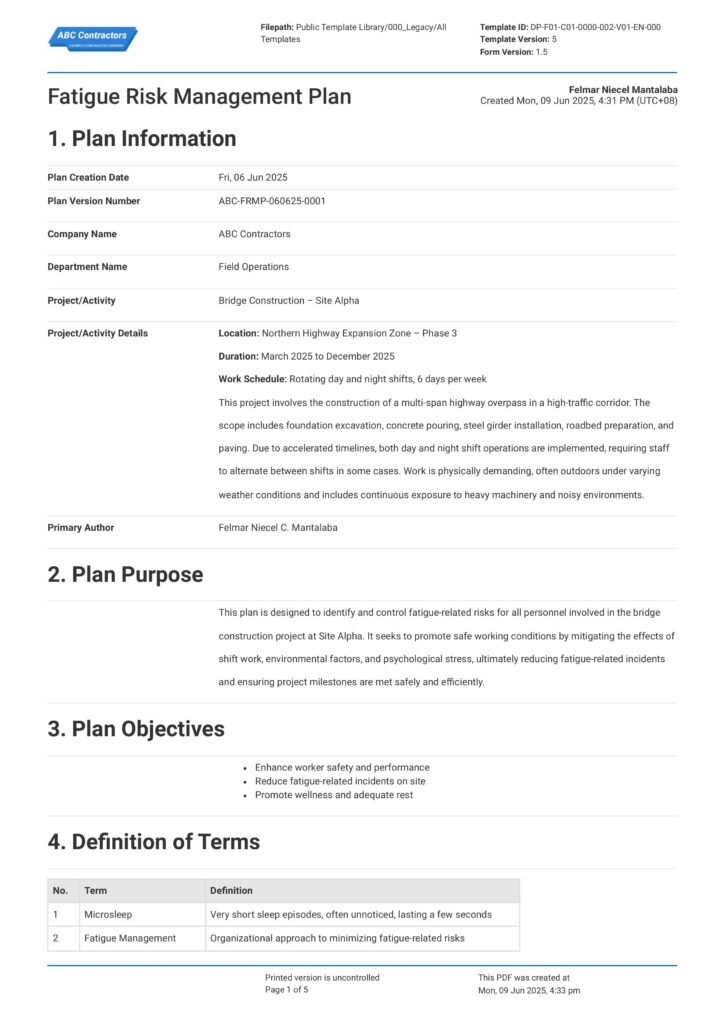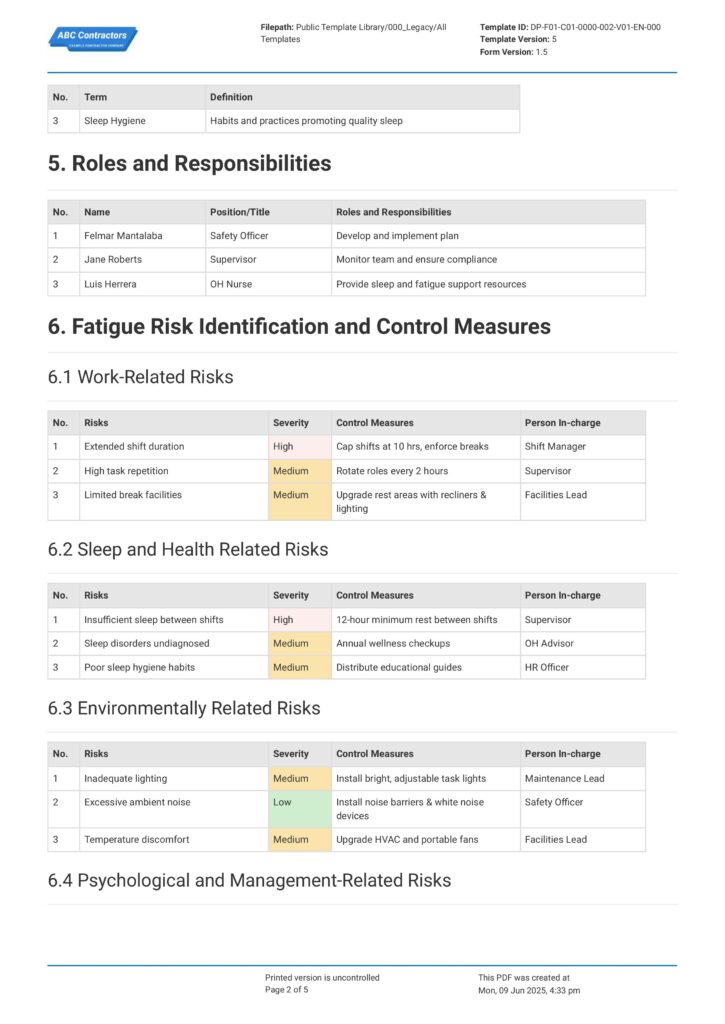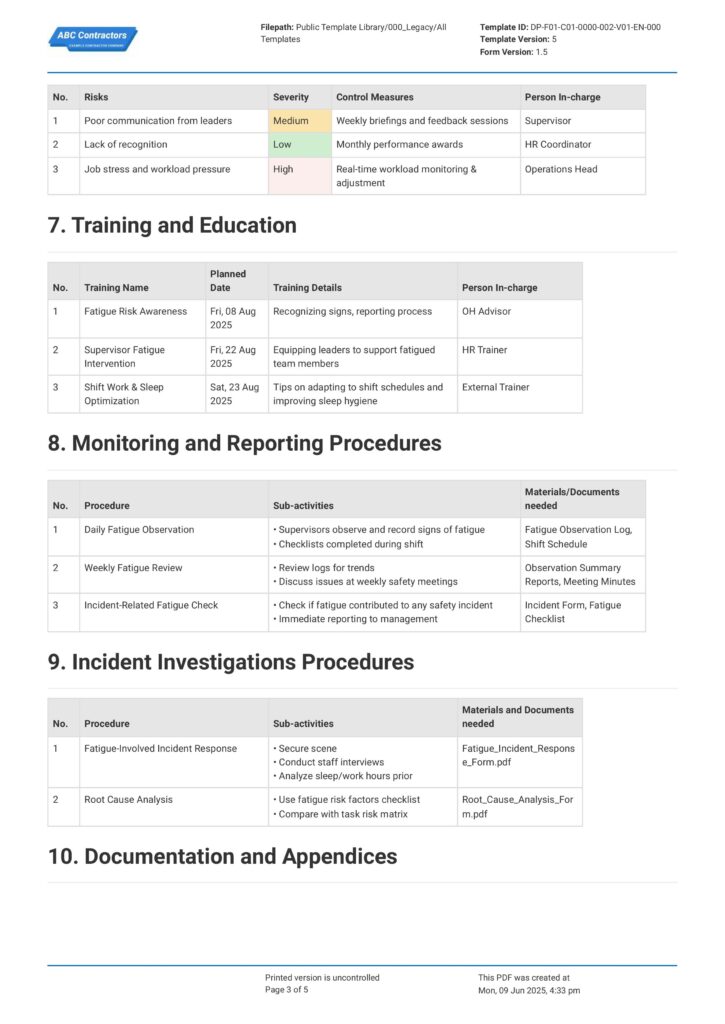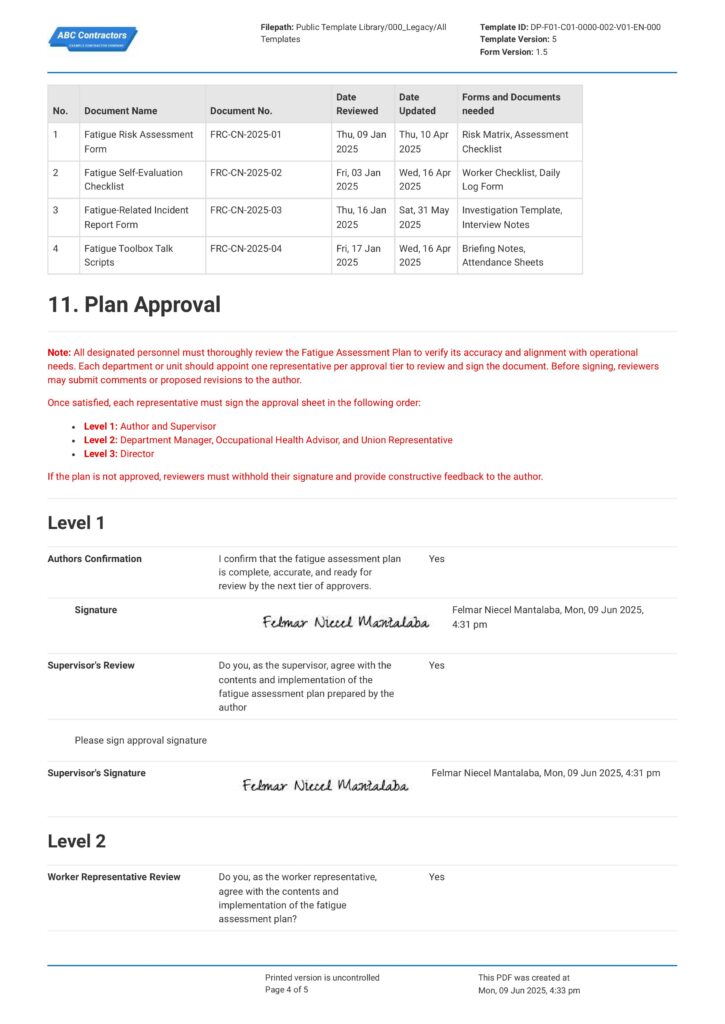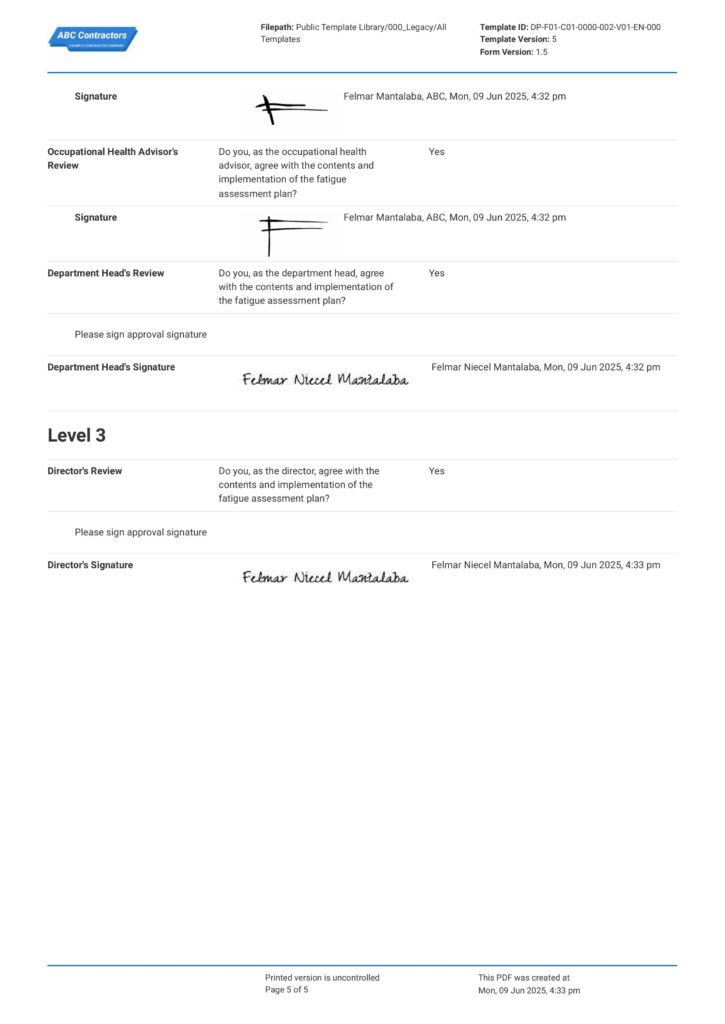Article Page – OSHA Fatigue Risk Management
OSHA Fatigue Risk Management
Fatigue is one of the most overlooked risks in the workplace and here, we'll see how OSHA addresses it and how free tools and resources can ensure overall workforce safety, and risk and fatigue management.

Table of Contents
Article Summary
- This article details what Fatigue Management is as defined by OSHA, why it is a major work hazard, and how programs can improve overall worker safety and compliance.
- To manage fatigue effectively, OSHA has placed responsibilities on both the employee and the employer. Employees are expected to manage their sleep and rest when outside of work, while the employer should ensure that the fatigue management plan is established and continuously implemented.
- Effectively implementing the OSHA fatigue risk management practices requires companies to provide training, conduct regular fatigue monitoring, continuously improve the fatigue risk management program, and other fatigue management strategies.
Why does Fatigue Risk Management matter to OSHA?
OSHA Fatigue Risk Management (FRM) matters as it plays a vital role in mitigating fatigue-related hazards in the workplace. OSHA highlights fatigue as a serious risk because it leads to an increase in errors in the workplace by negatively affecting a worker’s response time, decision-making capability, productivity, and performance.
According to OSHA, fatigue is one of the contributing factors in major incidents such as the 2005 Texas City BP oil refinery explosion, the 2009 Colgan Air crash, the explosion of the space shuttle Challenger, and the nuclear accidents at Chernobyl and Three Mile Island.
OSHA encourages companies to create and implement Fatigue Risk Management Practices. This should include establishing a fatigue risk management plan, regularly monitoring fatigue in the workplace, and providing employees awareness about fatigue and its effects. By doing so, companies can ensure a fatigue-free environment and maintain a safe and healthy workplace.
How to format your OSHA Fatigue Management Program?
Fatigue raises the risk of injuries and illnesses. To effectively eliminate this, companies must fabricate and implement a Fatigue Risk Management plan. When creating the plan, they should thoroughly identify the fatigue-related hazards in the workplace and provide controls that effectively eliminate or mitigate those hazards.
This approach systematically addresses fatigue, thereby preventing accidents before they occur. To give you a clearer picture of how a plan should be made, the example below shows a well-structured Fatigue Risk Management Plan.
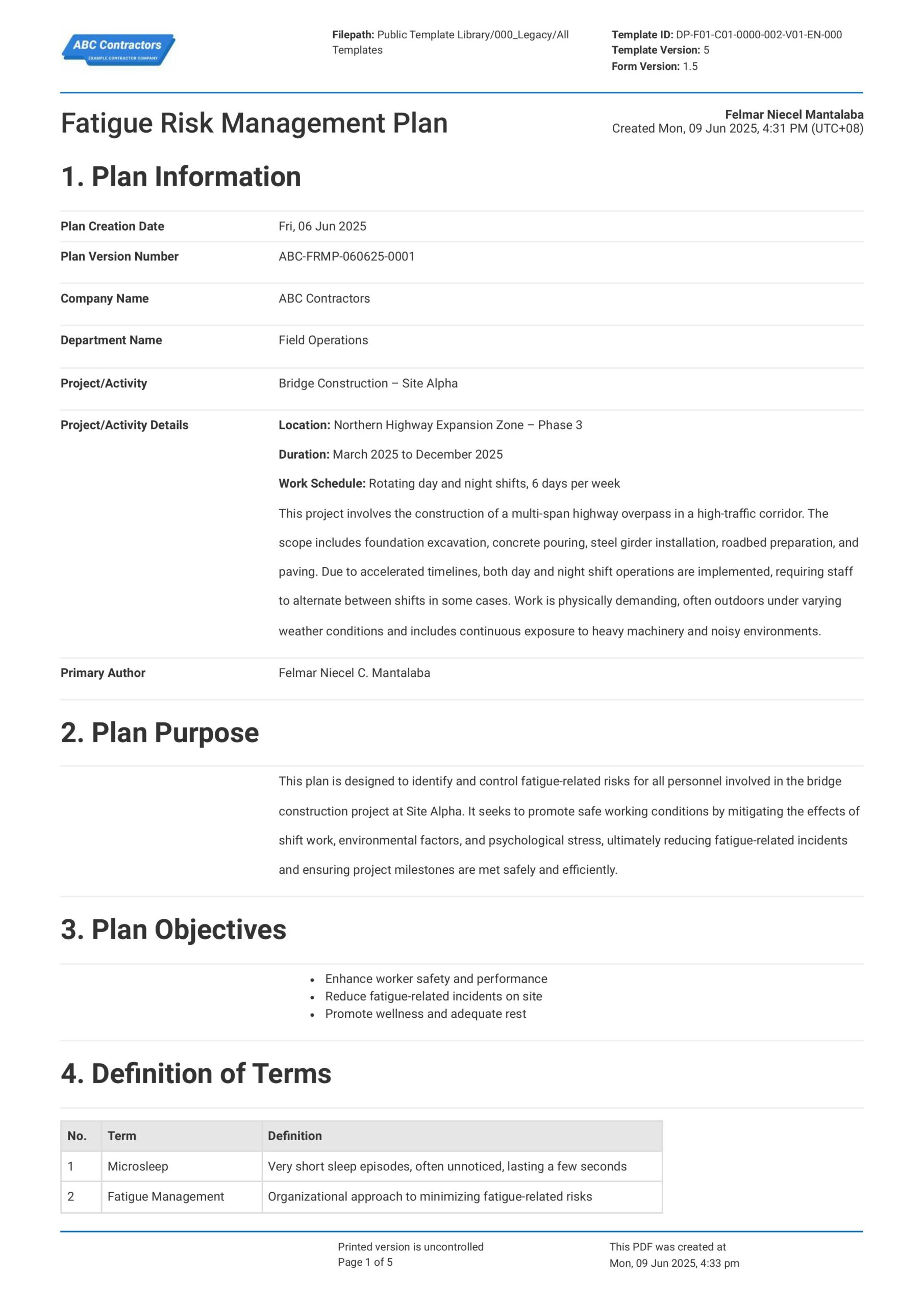
Use this Fatigue Risk Management Plan format for free
What are the OSHA Fatigue Rules?
OSHA fatigue rules have provisions on the employer and employee’s responsibilities. These shared responsibilities help define how each party should properly manage and prevent fatigue-related hazards in the workplace. The following are their responsibilities:
Employer’s Responsibility in OSHA Fatigue Risk Management
Employers play an important part in providing a safe and healthy environment for their employees. To manage fatigue effectively, they should begin by investigating factors related to it. They could look into staffing concerns, scheduled and unscheduled absences, understaffed departments, imbalanced workloads, and extended work hours—all of which increase the levels of fatigue and fatigue-related incidents.
After completing the investigation, employers can begin developing the OSHA Fatigue Risk Management Program based on the findings. The program should detail all identified fatigue-related hazards, control measures for each identified fatigue-related hazard, procedures for fatigue mitigation, and schedules for training and awareness. By using the workplace data, employers can ensure that their Fatigue Risk Management plan is practical, targeted, and fully effective in reducing fatigue-related risk when implemented. Employers must continuously develop the plan after implementation, particularly when changes occur and new hazards emerge.
Employee’s Responsibility for a fatigue-free mindset
Certain factors that contribute to fatigue, such as poor sleeping habits and the consumption of substances that affect sleep quality, are beyond the employer’s control. As a result, OSHA has outlined specific responsibilities for employees to ensure they remain fit for work.
- Employees must make sure that their sleep period is 7-9 hours daily without disruptions.
- Employees should try to sleep at the same time every day.
- Employees should avoid drinks with caffeine prior to bedtime to improve sleep quality.
- If working evenings or nights, employees must make sure that sleep has occurred within the last 8 hours before going to work.
- If napping before work, employees make sure that the duration is less than 45 minutes or greater than 2 hours to allow for a complete sleep/wake cycle.
- Employees must ensure that the sleeping environment is comfortable, cool, dark, and quiet.
- Employees are recommended to exercise regularly, eat a balanced diet, and maintain a healthy weight.
- Employees are suggested to keep a sleep diary and talk to their doctor when they have difficulty sleeping
OSHA Risk Assessment Example
Most employees tend to ignore fatigue at work because they are unaware of its effects. However, being oblivious does not excuse the worker from the dangers it brings. Identifying these fatigue-related risks through a risk assessment would enable the provision of appropriate controls. To better understand how to conduct this, here is an example:
In the construction industry, rebar installation on an elevated platform is a common yet hazardous activity, especially if an employee doesn't have enough sleep. A risk assessment must be conducted to eliminate the hazards.
The first step in doing the risk assessment is to identify all the hazards found in each procedure and its inherent risk.
The next step is to score the risk using the Risk Assessment Matrix. The severity and likelihood are either Low, Medium, and High. Using the Risk Assessment Matrix, navigate the risk level results for each hazard.
The third step is to provide the right control measures for each hazard identified. You can use the hierarchy of controls as a reference when selecting the control measures.
Lastly, It is essential to convey the risk analysis to the relevant workers and get their signatures on the THA form to verify that they have finished the Toolbox Talk and understood the risk posed in the activity.
How to effectively implement the OSHA Fatigue Risk Management practices
The fatigue risk management practices can only become effective if their implementation is continuous. To achieve continuous implementation, companies must either have or conduct the following activities:
Training and Awareness
Educating employees about fatigue and the procedures to mitigate it can help them understand its potential dangers and take proactive steps to manage their energy levels. Regular trainings, toolbox talks, and visual reminders reinforce safe behavior and promote a fatigue-free workplace.
Fatigue Monitoring
Implementing a fatigue monitoring system is important for sustaining fatigue risk management, as these practices rely on the data collected from this activity. This includes information from assessments like the Fatigue Self-Assessment Form or the Fatigue Risk Calculator, as well as reports from any fatigue-related incidents. Having such data also empowers employees to report when they are unfit for duty—without fear of blame.
Continuous Improvement
A successful FRMP is never static. It is continuously updated to reflect new procedures, newly identified hazards, and concerns and feedback given by any of the workers. This approach helps the program remain effective and timely to varying workplace conditions.
A smart solution to fatigue risk management
Creating all the required documents for your Fatigue Risk Management is never simple, especially when doing it manually. You must spend many hours creating the documents from scratch, printing them, and compiling them in whatever little space you have left in your cabinet. And let’s not forget that creating these documents is not a one-time process; you have to constantly update the plan to ensure that your work environment is always free from fatigue-related hazards.
Fortunately, there is now a smart way to do this. With the Fatigue Risk Management App, you can create a simple fatigue management process while improving your overall productivity. With features that automate your entire workflow, you can easily conduct fatigue assessments, record incident data, track trends, and generate reports—all in one place. The process helps you save precious time but also ensures that fatigue is managed effectively, helping you build and maintain that safe and healthy work environment.
Summary of OSHA Fatigue Risk Management
OSHA’s approach to fatigue risk management highlights how important it is to understand fatigue as a workplace hazard. Because of this, companies must provide appropriate control measures to manage these fatigue-related hazards and effectively implement them. One of the best ways to achieve this is to create a fatigue risk management program. The program outlines all the essential procedures and controls, establishing them as standards for everyone to follow. With an effective risk management plan, companies just don't fight fatigue—they build a safer, healthier, and more sustainable working environment.
Frequently Asked Questions
Is the Fatigue Risk Management Program needed in different industreis?
Yes - a Fatigue Risk Management Program (FRMP) is needed across various industries, but it is especially crucial in high-risk sectors like mining, construction, transportation, and manufacturing. These industries often involve long shifts, physically demanding tasks, and high-stakes operations where even a moment of fatigue can lead to serious accidents or costly errors. By implementing an FRMP, companies in these fields can proactively manage fatigue-related risks, protect their workforce, and maintain safe, productive operations.
How is technology transforming the way Fatigue Risk Management Programs are developed and implemented?
Technology is reshaping how Fatigue Risk Management Programs are created by moving away from paper forms and manual processes to digital platforms like Dashpivot. These tools allow teams to streamline fatigue assessments, automate documentation, and access real-time insights from any device. As a result, organizations benefit from increased efficiency, more accurate data, and safer, more responsive work environments.
Does Sitemate offer templates for fatigue monitoring?
Yes - Sitemate offers ready-to-use and editable Fatigue Risk Calculator that can also be edited for your workflow. Companies of all sizes in different industries are using these templates right now to streamline their process of identifying accurately the fatigue levels of their workers
Related resources

Fatigue Risk Calculator
Log worker hours and identify if workers are practicing a work-life balance.

Fatigue Risk Management Plan
Plan and structure your employee roles and responsibilities to reduce fatigue in the workplace.

Fatigue Self-Assessment Form
Use this questionnaire to assess the degree of exhaustion among workers to improve well-being and enhance work quality.
